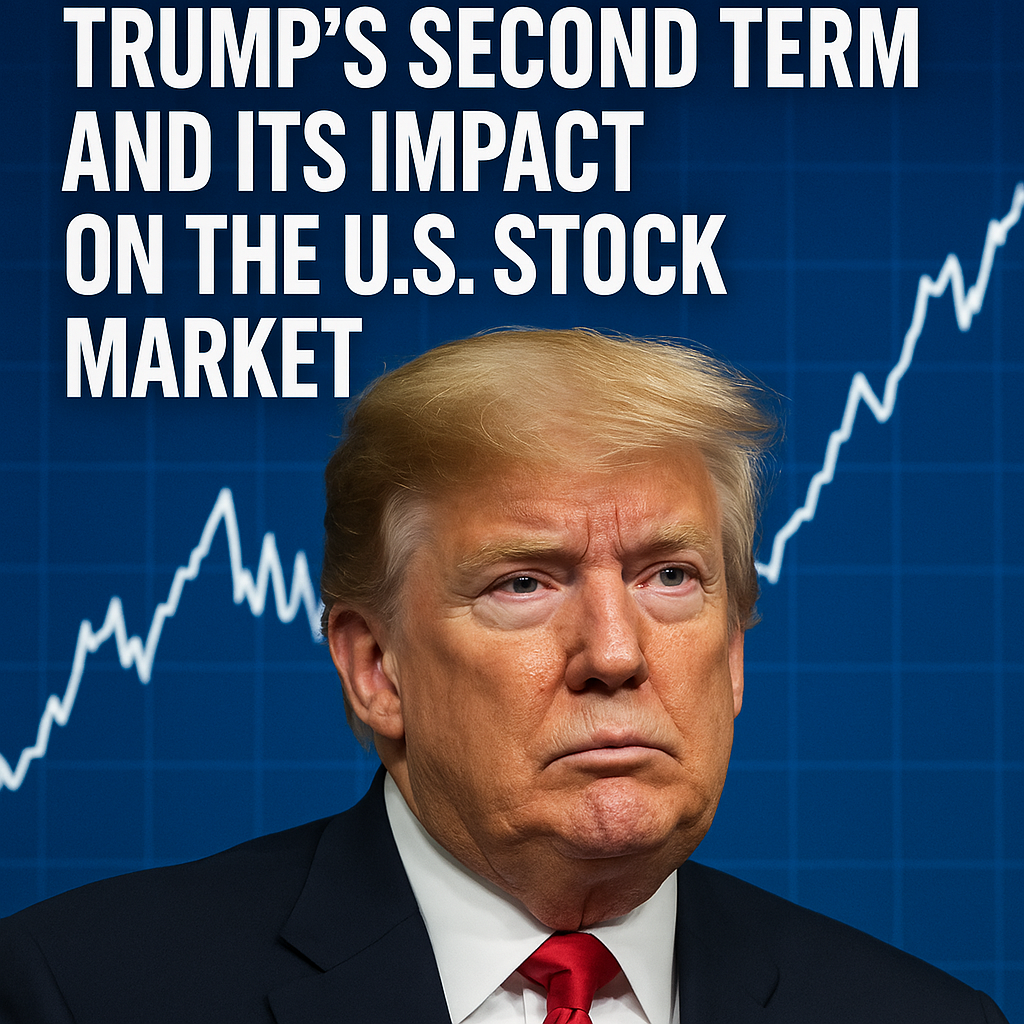Introduction: Trump Is Back — What’s Next for Wall Street?
Donald J. Trump began his second term as the 47th President of the United States on January 20, 2025. His return to the Oval Office has already reshaped the market’s expectations. With promises of tax cuts, deregulation, and confrontational trade policies, investors are preparing for a new era of volatility and opportunity.
In this article, we analyze how Trump’s second term is impacting the U.S. stock market, sector by sector, and what investment strategies might make sense going forward.
Market Reactions Since January 2025
The S&P 500 jumped 2.8% in the days following Trump’s inauguration, reflecting bullish sentiment around corporate tax cuts and deregulation.
However, this rally faded as investors reacted to:
- New tariffs on Chinese and European imports, targeting semiconductors and auto parts (Reuters)
- Tensions with the Federal Reserve, with Trump calling for urgent rate cuts
- Rising VIX levels, peaking at 24, signaling elevated investor anxiety (MarketWatch)
Trump’s Second-Term Agenda: Key Economic Policies
1. Corporate Tax Cuts (Again)
Trump is proposing to lower the corporate tax rate from 21% to 15%, building on the 2017 Tax Cuts and Jobs Act.
According to Investopedia, this move could boost corporate earnings by 5–8%, especially in capital-intensive sectors.
2. Reciprocal Tariffs and Trade Pressure
Trump has revived his signature idea of “reciprocal tariffs”, introducing a tariff model that mirrors how other countries tax American goods.
Chinese imports now face an average 34–54% tariff, affecting electronics, solar panels, and machine tools. European auto exports are under scrutiny as the administration demands “fair trade” agreements.
3. Attacks on the Fed
Trump publicly criticized the Federal Reserve for maintaining interest rates above 4.5%, urging aggressive cuts to stimulate growth. This political tension is reminiscent of his first term, when similar pressure influenced short-term rate decisions — unsettling markets then, and now.
Sector Impact Analysis
| Sector | Outlook | Notes |
|---|---|---|
| Energy | 🟢 Positive | Trump supports fossil fuels, pipeline expansion, and deregulation |
| Defense | 🟢 Positive | Military budget increases benefit Lockheed Martin, Northrop Grumman |
| Technology | 🟠 Mixed | Tax cuts help profits, but tariffs hurt global supply chains |
| Financials | 🟢 Positive | Bank deregulation and possible rate cuts may raise profit margins |
| Consumer Goods | 🔴 Negative | Higher import costs, especially in electronics and fashion |
| Green Tech | 🔴 Negative | Clean energy tax credits reduced; wind/solar stocks down 9% in Q1 2025 |
📌 CNBC: Sector Response to Trump’s Second Term
nvestor Sentiment: What the Big Players Are Saying
- Goldman Sachs: “Markets are reacting positively to tax cuts but remain cautious about global trade shocks.”
- Morgan Stanley: “We expect increased divergence between defensive and cyclical stocks.”
- BlackRock: “Volatility will define 2025. Diversification is essential.”
Investor Strategy: How to Navigate Trump’s Market
Smart investors should consider:
- Overweight: Energy, Defense, Regional Banks
- Underweight: Consumer Discretionary, Chinese Tech Stocks
- Use options to hedge volatility (e.g. VXX ETF)
- Short-term bonds: If rates drop, bond prices may rise
🛠️ Tool: Finviz Screener to find high-potential Trump-aligned stocks
Federal Reserve Outlook: Political Tension Meets Monetary Policy
Trump’s confrontational approach to the Fed introduces uncertainty. If the Fed resists his push for rate cuts, markets may fear a policy stalemate. If it concedes, concerns about independence may arise.
According to CNBC, 60% of institutional investors believe the Fed’s credibility could be at risk.
Global Reactions
- China: Retaliated with tariffs on U.S. agriculture and rare earths.
- EU: Moved toward digital and carbon taxes on U.S. firms.
- Emerging Markets: Facing capital outflows and slower export growth.
Long-Term Outlook
| Driver | Bullish Scenario | Bearish Scenario |
|---|---|---|
| Corporate Tax Reform | Boosts EPS and reinvestment | Increases deficit, raises inflation |
| Trade Strategy | Leads to renegotiated favorable deals | Sparks global slowdown due to protectionism |
| Fed Policy | Aligns with growth targets via rate cuts | Political interference disrupts stability |
| Global Geopolitics | Avoids major conflict | Tensions disrupt supply chains and confidence |
Portfolio Recommendations
- Overweight: Energy, Defense, Regional Banks
- Underweight: Consumer Discretionary, China-exposed Tech
- Hold Short-Term Bonds: Benefit if rates decline
- Hedge Volatility: Consider VIX-related ETFs
Tools to Monitor Market Moves
Final Word: Trump’s America Demands an Adaptive Strategy
Donald Trump’s second term is not merely a rerun — it’s a remix in a very different global and technological era. Markets will reward those who adapt quickly to new policies, sector shifts, and interest rate moves.
For investors, adaptability is the alpha. There will be winners and losers — and the difference will come down to your ability to interpret Trump’s tweets, tariffs, and tax code changes.
Stay diversified, stay informed, and most importantly — stay agile.
Additional Market Outlook for H2 2025
Looking ahead to the second half of 2025, analysts are forecasting increased divergence between growth and value stocks. Energy and industrials are expected to outperform if fiscal stimulus is passed, while consumer discretionary may lag due to persistent inflation and wage pressure.
Geopolitical risks—particularly in the South China Sea and Eastern Europe—remain a wildcard. Any flare-ups could shift capital flows toward safe havens like gold, utilities, and the U.S. dollar.
Institutional investors are increasingly moving toward tactical allocation models that allow real-time portfolio adjustment based on political headlines and central bank speeches. Retail investors are advised to stay informed through diversified sources and remain cautious about overexposure to single sectors.
AI-driven financial tools are also playing a growing role in investment decisions. Portfolio managers are leveraging machine learning to detect correlations between policy shifts and sector performance — a trend that will likely accelerate in the Trump 2.0 era.
Disclaimer
This article is for informational purposes only and does not constitute financial advice. Please consult a qualified financial advisor before making any investment decisions.








